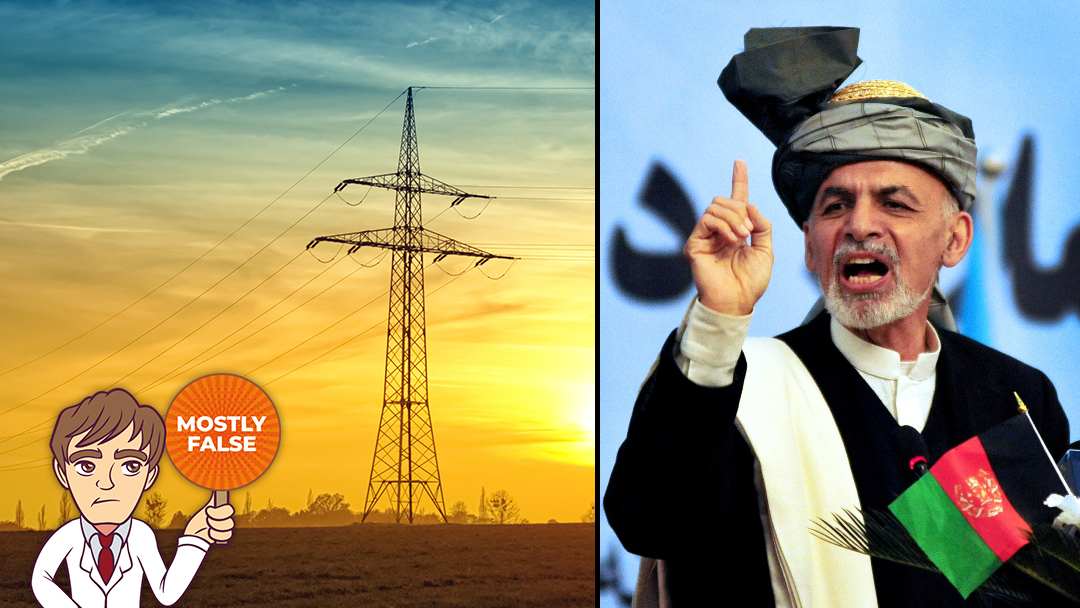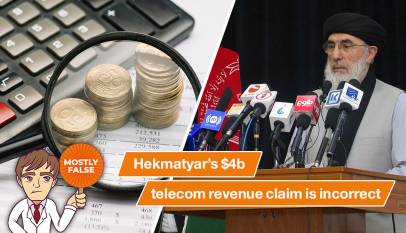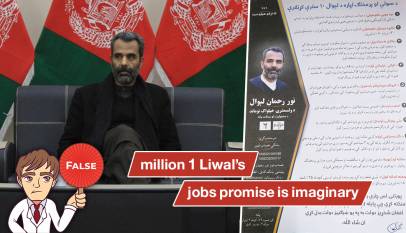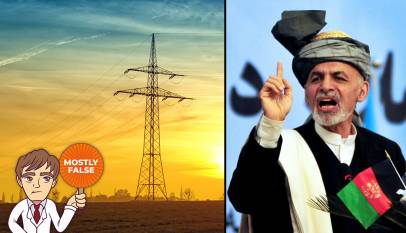Power supply to all districts an unviable promise
KABUL (Pajhwok): President Ashraf Ghani’s promise to supply electricity to all districts of Afghanistan in two years seems impracticable.
Expertsview the promise asan unrealistic election campaign slogan, saying people should not believe in such vows.
President Ghani, who is running for re-election, told his first campaign gathering on August 28 in Kabul: “Every district of Afghanistan will have electricity within two years. Power will also be supplied to villages on the other side of the Durand Line within four years.”
Pajhwok Afghan News has researched the possibilityof keeping the promise. Before going into further details, it is important to understand the current level of people’s access to electricity.
Currentlevel of access to electricity
Relevant sources provide different numbers of people having access to electricity.
WahidullahTawhidi, spokesman for Da Afghanistan BreshnaShirkat (DABS), told Pajhwok Afghan News that six percent of Afghans had access to electricity about 10 years ago but the number has now jumped to 45 percent.
The Ministry of Water and Energy says nearly 43 percent of people enjoy the facility. But a ministry official, who declined to be named, put the number at 30 percent.
An average of figures from the three sources shows that about 61 percent of Afghans presently have access to electricity.
How long will it take for all people to gain access to electricity?
If re-elected, Ghani says all districts of the countries will have electricity within two years and villages on the other side of Durand Line will be electrified in three to four years.
The DABS spokesman says under a plan, electricity supply will surge to 59 percent in two years.
About Ghani’s promise, Tawhidi said: “The government may have strategies and plans. If they have a viable strategy, the commitment will definitely be honoured.”
FarhadMahmoodi, an official of MoWE, believes 75 percent of people would get access to electricity with the implementation of the five years plan (2020-2025).
With regard to the presidential promise, he said they would encourage the private sector to invest in power projects, huge and small.
But a source in MoWE, speaking on condition of anonymity, revealed: “The government has held out certain commitments to the international community. Under the Sustainable Development Goals (SDGs), the government should provide electricity to all citizens by the end of 2030.”
But he acknowledged Afghanistan could not achieve the goal due to problems in financial, security, management and leadership areas.
“Our affairs are currently not going according to the plan. We are way behind,” he admitted.
Referring to Ghani’s commitment, the source added: “Many of the programmeswe have announced tend to be based on the election campaign and their implementation requires a lot of time and resources.”
He said the timeline for a power dam in the ShakarDaradistrict of Kabul had been extended several times. It meansthe project has not been executed on schedule.
Based on comments from the sources, electricity supply to all districts within two years is impossible.
Pajhwok has evaluated the presidential promise of supplying electricity to all districts in light of domestic revenue, resources, foreign assistance, private sector investment and imported electricity.
Afghanistan revenue, domestic electricity generation
DABS spokesman said, “We have currently 1,300 to 1,400 MW of electricity in the country but we would need 7,000 to 8,000 MW of electricity for nationwide consumption.”
Afghanistan could produce up to 58,000 MW of electricity but it required domestic and foreign investments, he added.
According to Pajhwok Afghan News report, the Afghan government’s revenue in 2018 was 189 billion afghanis. According to Ministry of Water and Energy, power could be generated from water, coal, sun and wind and each MW costs around 1.5 million US dollars (to be produced).
Based on information from the two sources, producing 7,500MW of electricity on average would cost 11.25 billion US dollars, about five times higher of the country’s annual revenue.
The Ministry of Water and Energy says its five-year plan for providing electricity to the whole of the country requires $13 billion.
Figures show it is impossible for the government to provide electricity to the whole of the country from domestic revenue in two years.
Foreign aid
Shamroz Khan Masjedi, spokesman for the Ministry of Finance (MoF), said that the international community had so far provided $3.4 billion in assistance to Afghanistan for electricity.
In response to a question whether Afghanistan would be able to provide $13 billion from its own revenue for electricity, he gave an unspecified answer and said, “MoF has not been asked so far for providing this amount of money, if we are asked, the ministry would share its technical view with the officials.”
The international community in 2016 in Brussels pledged $15.2 billion in assistance to Afghanistan until 2020 for development projects.
Afghan officials had said that the international community would provide $3.8 billion to Afghanistan each year until 2020.
Considering that Afghanistan needs this financial assistance for its development plans, it would be not possible for the government to provide electricity to all districts of the country in two years even if the whole aid is allocated for this specific area.
Private sector investments
Jan Aqa Navid, spokesman of Afghanistan Chamber of Commerce and Industry (ACCI), said that the private sector had not been able to invest that huge amount of money to provide electricity to the whole of the country in two years.
“If the security situation stabilizes and the private sector is provided with needed facilities and loans with easy conditions, then it would be possible for the private sector to make electricity available in the entire country in a period of five to 10 years,” he said.
Without giving details, Navid said the private sector had invested on the second dam of Sarobi in Kabul and production of electricity from Shiberghan gas and oil fields , a process he said would take three to six years.
Imported electricity
According to DABS, Afghanistan currently has 1,300 to 1,400 MW of electricity, with 80 percent being imported.
Wahidullah Tawhidi said 2,000 MW more electricity would be imported from Uzbekistan and Turkmenistan and around 300 MW electricity would be produced domestically until 2021 according to the power utility’s plan.
“CASA-1000 project which would start in a few days or weeks would give people access to electricity across the Durand Line, it is a project of 1,300 MW electricity that would be implemented in two years, the Ministry of Water and Energy has more than 60 projects, which are underway,” he said.
The Ministry of Water and Energy in 2016 also said that procurement process of CASA-1000 project would be completed during that year and practical work on the project would start in the beginning of 2018, but practical work on the project is yet to be started.
An official of the Ministry of Water and Energy, who wished to go unnamed, about President Ghani’s promise to provide electricity to the whole of the country in two years, said, “It is impossible.”
He said 2030 had been set as the deadline for providing electricity to all the people in Afghanistan based on Sustainable Development Goals (SDGs) program, a goal he said was not possible to be achieved in 2021.
The statements above show it is not possible for the Afghan government to increase electricity by 1,300 MW to 7,500 MW in the next two years.
However, Javid Ghafor, a spokesman for Ashraf Ghani, a presidential candidate, about views of different sources regarding the impossibility of Ghani’s plan, said, “Afghanistan has many opportunities, we can produce power from our own sources such as sun, wind and water, Ghani has worked on it.”
He said electricity would be also transferred from central Asia to South Asia through Afghanistan and Afghanistan would also get a huge benefit from it.
“Nine provinces were connected with electricity during the last few years, we would also be able to deliver the facility to more provinces and districts in the next two years,” he said.
Do not trust electioneering promises
Saifuddin Saihoon, a lecturer of economics in Kabul University, about Ghani’s promise, said, “It is an imaginary promise and its implementation is impossible.”
“If we want to supply electricity to all our districts then we have to create the required projects, measure our energy sources and create networks which require much human and financial abilities and time,” he said.
Considering the country’s current situation, it is not possible by any means to implement such giant projects even in the next 10 years, he said, adding that such projects required at least $12 billion and at least 10 years in a safe stable environment.
“Don’t take electioneering promises serious, they are common during elections in the world for attracting votes,” he said.
Ghani in the past had also made similar pledges, he added. Citing an example, he said Ghani during 2014 election had said that he would bring positive changes to people’s lives, but rather he turned people’s situation had.
According to reports, poverty level in Afghanistan has increased from 39 percent in 2014 to 54 percent in 2018.
Saihoon said deceptive pledges caused negative consequences as people would lose trust in candidates and would not participate in elections.
Pajhwok Afghan News assesses presidential candidates’ promises and explains how much they are executable or in what category, (good, fair, a little good, a little not good and not good), they are placed.
Pajhwok’s assessment team, learning from different sources and information, says that providing electricity to the whole of the country in the next two years is impossible but it is possible to expand electricity to some areas.

Ahmad Shah Erfanyar
Hits: 18897
Hekmatyar’s $4b telecom revenue claim is incorrect
KABUL (Pajhwok): Pajhwok Afghan News findings show presidential candidate Gulbuddin Hekmat…



